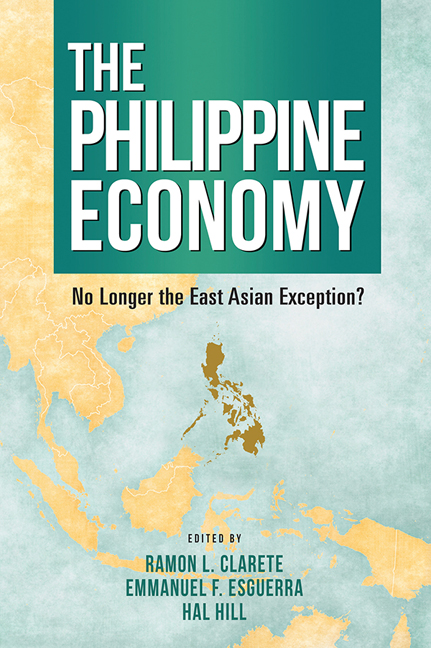Book contents
- Frontmatter
- Contents
- List of Figures
- List of Tables
- Foreword by Arsenio M. Balisacan
- Preface
- About the Contributors
- 1 The Philippine Economy: An Overview
- 2 Economic Growth and Poverty Reduction
- 3 Infrastructure and Urbanization
- 4 Education and Training
- 5 Universal Health Coverage, Health Security and Resilient Health Systems
- 6 Environmental Resources, Shocks and National Well-Being
- 7 Energy: Power Security and Competitiveness
- 8 Development Finance
- 9 Governance and Institutions
- Index
Foreword by Arsenio M. Balisacan
Published online by Cambridge University Press: 12 February 2019
- Frontmatter
- Contents
- List of Figures
- List of Tables
- Foreword by Arsenio M. Balisacan
- Preface
- About the Contributors
- 1 The Philippine Economy: An Overview
- 2 Economic Growth and Poverty Reduction
- 3 Infrastructure and Urbanization
- 4 Education and Training
- 5 Universal Health Coverage, Health Security and Resilient Health Systems
- 6 Environmental Resources, Shocks and National Well-Being
- 7 Energy: Power Security and Competitiveness
- 8 Development Finance
- 9 Governance and Institutions
- Index
Summary
It gives me great pleasure and honour to provide the introductory message for this rather impressive volume on the Philippine economy. Authored by renowned Filipino scholars and serious observers of the Philippine economy, the volume is arguably the most comprehensive reference work on the economy since at least the global financial crisis in 2008–9 and will likely shape the thinking and practice of Philippine development policy in the years ahead.
This volume had its beginning, albeit accidental, during my stint as Socioeconomic Planning Secretary and, concurrently, Director- General of the National Economic and Development Authority under the administration of President Benigno S. Aquino III. At that time, in early 2014, I got hold of the ADB Report entitled Asia 2050: Realizing the Asian Century, and it caught my interest. The report talked about how Asia is in the middle of a historic transformation. To quote the report: “If it continues to follow its recent trajectory, by 2050 its per capita income could rise six-fold in purchasing power parity (PPP) terms to reach Europe's levels today. It would make some 3 billion additional Asians affluent by current standards. By nearly doubling its share of global gross domestic product (GDP) to 52 percent by 2050, Asia would regain the dominant economic position it held some 300 years ago, before the industrial revolution.”
It was an exciting prospect for Asia, except for the Philippines. In the Report, the Philippines was a slow- or modest-growth aspiring country, lumped in the same group as Afghanistan, Bangladesh, North Korea, Laos, Myanmar, Nepal, Pakistan, and many of the Pacific Island countries. Even the Report's epic video-production did not make any reference to or show any significant Philippine landmark. That was, of course, understandable, given the country's poor-growth record in the three decades before 2010, which was the report's database for its extrapolation of the future. In contrast, since at least 2010, the country's economic performance has been quite stellar, impressively even earning the title 'the rising tiger of Asia', among other accolades bestowed upon the Philippine economy by various global development observers, e.g., the World Bank and HSBC.
- Type
- Chapter
- Information
- The Philippine EconomyNo Longer The East Asian Exception?, pp. xix - xxivPublisher: ISEAS–Yusof Ishak InstitutePrint publication year: 2018

